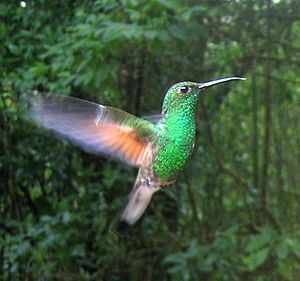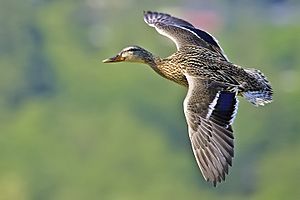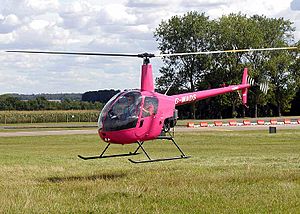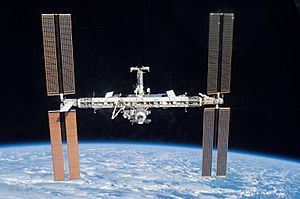Flight facts for kids

Flight, or flying - a process of movement of the object in a gaseous environment or a vacuum without contact with the surface of another environment, as is possible with the use of jet thrust, or other means of propulsion, and without it (by inertia). Best adapted for long controlled powered flight are flying birds and insects, and mammals of the order Chiroptera and extinct reptiles of the order pterosaurs. All of these animals use the aerodynamic principles of flight, using the load-bearing properties of the wing. There are also many animals that make gliding and parachute flight, such as spiders web, aeroplankton flying clams and flying fish, intending to use the ear or leather folds, mammals and reptiles. The fastest flying animal is the peregrine falcon. The speed of its dive is over 370 kilometres per hour (230 miles per hour).
Contents
Types of flight
Buoyant flight
Humans have managed to construct lighter than air vehicles that raise off the ground and fly, due to their buoyancy in air.
An aerostat is a system that remains aloft primarily through the use of buoyancy to give an aircraft the same overall density as air. Aerostats include free balloons, airships, and moored balloons. An aerostat's main structural component is its envelope, a lightweight skin that encloses a volume of lifting gas to provide buoyancy, to which other components are attached.
Aerostats are so named because they use "aerostatic" lift, a buoyant force that does not require lateral movement through the surrounding air mass to effect a lifting force. By contrast, aerodynes primarily use aerodynamic lift, which requires the lateral movement of at least some part of the aircraft through the surrounding air mass.
Aerodynamic flight
Unpowered flight versus powered flight
Some things that fly don't generate propulsive thrust through the air, for example, the flying squirrel. This is termed gliding. Some other things can exploit rising air to climb such as raptors (when gliding) and man-made sailplane gliders. This is termed soaring. However most other birds and all powered aircraft need a source of propulsion to climb. This is termed powered flight.
Animal flight


The only groups of living things that use powered flight are birds, insects, and bats, while many groups have evolved gliding. The extinct Pterosaurs, an order of reptiles contemporaneous with the dinosaurs, were also very successful flying animals. Each of these groups' wings evolved independently. The wings of the flying vertebrate groups are all based on the forelimbs, but differ significantly in structure; those of insects are hypothesized to be highly modified versions of structures that form gills in most other groups of arthropods.
Bats are the only mammals capable of sustaining level flight. However, there are several gliding mammals which are able to glide from tree to tree using fleshy membranes between their limbs; some can travel hundreds of meters in this way with very little loss in height. Flying frogs use greatly enlarged webbed feet for a similar purpose, and there are flying lizards which fold out their mobile ribs into a pair of flat gliding surfaces. "Flying" snakes also use mobile ribs to flatten their body into an aerodynamic shape, with a back and forth motion much the same as they use on the ground.
Flying fish can glide using enlarged wing-like fins, and have been observed soaring for hundreds of meters. It is thought that this ability was chosen by natural selection because it was an effective means of escape from underwater predators. The longest recorded flight of a flying fish was 45 seconds.
Most birds fly (see bird flight), with some exceptions. The largest birds, the ostrich and the emu, are earthbound, as were the now-extinct dodos and the Phorusrhacids, which were the dominant predators of South America in the Cenozoic era. The non-flying penguins have wings adapted for use under water and use the same wing movements for swimming that most other birds use for flight. Most small flightless birds are native to small islands, and lead a lifestyle where flight would offer little advantage.
Among living animals that fly, the wandering albatross has the greatest wingspan, up to 3.5 meters (11 feet); the great bustard has the greatest weight, topping at 21 kilograms (46 pounds).
Most species of insects can fly as adults. Insect flight makes use of either of two basic aerodynamic models: creating a leading edge vortex, found in most insects, and using clap and fling, found in very small insects such as thrips.
Mechanical

Mechanical flight is the use of a machine to fly. These machines include aircraft such as airplanes, gliders, helicopters, autogyros, airships, balloons, ornithopters as well as spacecraft. Gliders are capable of unpowered flight. Another form of mechanical flight is para-sailing where a parachute-like object is pulled by a boat. In an airplane, lift is created by the wings; the shape of the wings of the airplane are designed specially for the type of flight desired. There are different types of wings: tempered, semi-tempered, sweptback, rectangular and elliptical. An aircraft wing is sometimes called an airfoil, which is a device that creates lift when air flows across it.
Supersonic
Supersonic flight is flight faster than the speed of sound. Supersonic flight is associated with the formation of shock waves that form a sonic boom that can be heard from the ground, and is frequently startling. This shockwave takes quite a lot of energy to create and this makes supersonic flight generally less efficient than subsonic flight at about 85% of the speed of sound.
Hypersonic
Hypersonic flight is very high speed flight where the heat generated by the compression of the air due to the motion through the air causes chemical changes to the air. Hypersonic flight is achieved by reentering spacecraft such as the Space Shuttle and Soyuz.
Ballistic
Atmospheric
Some things generate little or no lift and move only or mostly under the action of momentum, gravity, air drag and in some cases thrust. This is termed ballistic flight. Examples include balls, arrows, bullets, fireworks etc.
Spaceflight
Essentially an extreme form of ballistic flight, spaceflight is the use of space technology to achieve the flight of spacecraft into and through outer space. Examples include ballistic missiles, orbital spaceflight etc.
Spaceflight is used in space exploration, and also in commercial activities like space tourism and satellite telecommunications. Additional non-commercial uses of spaceflight include space observatories, reconnaissance satellites and other earth observation satellites.
A spaceflight typically begins with a rocket launch, which provides the initial thrust to overcome the force of gravity and propels the spacecraft from the surface of the Earth. Once in space, the motion of a spacecraft—both when unpropelled and when under propulsion—is covered by the area of study called astrodynamics. Some spacecraft remain in space indefinitely, some disintegrate during atmospheric reentry, and others reach a planetary or lunar surface for landing or impact.
Images for kids
-
Human-invented flight: a Royal Jordanian Airlines Boeing 787
-
Lighter-than-air airships are able to fly without any major input of energy
See also
 In Spanish: Vuelo para niños
In Spanish: Vuelo para niños












